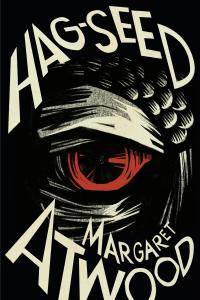About a year ago Hogarth Publishing reached out to a group of authors for what seemed like an impossible task; take a Shakespeare play and redo it for a modern audience. Eight authors took up the challenge: Tracy Chevalier; Margaret Atwood; Howard Jacobs; Anne Tyler; Jeanette Winterson; Edward St Aubyn; Gillain Flynn, and Joe Nesbo. You can read about it here http://hogarthshakespeare.com/
Although the lineup is impressive the news was met by a lot of criticism by authors, scholars, and the public alike. Why attempt to update the master when it is clear that his works still hold up? There were many an online discussions about the subject, and blog posts blasting the idea of modernizing Shakespeare. I had to laugh at the hypocrisy of one author who took a dim view to the Hogarth’s undertaking while making sure to let his readers knew he would be retelling Hamlet from Marcellus’ point of view.
The publishing house did not do its self any favors by the lack of explanation of how the authors were going to go about it. Many understood it to mean that these eight authors thought themselves worthy of changing words and scenes. The outcry over the “retooling” went on a little to long before it was announced in subsequent interviews that the author were simply taking the plots and retelling them as modern works literature.
Yet the unease that many felt was not allayed when the first go, Winterson’s book, The Gap of Time based on The Winter’s Tale, did not do well with mature book readers and critics alike. I picked it up while at the library one day and found that it read like a sappy young-adult novel, complete with short sentences and a heroine that sounded like a Disney Princess. I had to agree with the critics of the endeavor; if this was to be the norm then this was not going to turn out well. At least that was my opinion at the time. Oh but soon, I would learn just how wrong I was at least when it comes to Atwood’s book, Hag-Seed based on the Tempest.
Now, I have to be honest. I am no fan of Atwood. I read her book The Handmaiden’s Tale years ago and found it mildly disturbing. But I understand that she is a popular author so when the favorable reviews for Hag-Seed started popping up I simply chalked it up to her popularity with the masses. But once again Twitter prompted me to do a double take. Readers from all over started posting about how good it was. And so, one rainy day I decided to see what all the fuss was about.
One of my favorite things about the Amazon Kindle app is the ability to download a free book sample. So on this rainy day, I downloaded the sample and started reading. And to my amazement, I couldn’t put it down. Oh I had to read this book! The first two pages pull you in and demand your complete attention. Felix, the Prospero of this book had placed a spell on me, but not enough for me to purchase the Kindle edition. $13.00 for the opportunity to read a book that cannot be placed in a shelf of honor or passed to a close friend? Never!
I refuse to pay over $9.00 for a Kindle book (and even that hurts) so I searched my local library for a copy. The one and only copy was checked out but due back in a few days so I reserved it, and picked it up the following Friday. By Sunday morning I had finished the book.
From the publisher:
Felix is at the top of his game as Artistic Director of the Makeshiweg Theatre Festival. His productions have amazed and confounded. Now he’s staging a Tempest like no other: not only will it boost his reputation, it will heal emotional wounds.
Or that was the plan. Instead, after an act of unforeseen treachery, Felix is living in exile in a backwoods hovel, haunted by memories of his beloved lost daughter, Miranda. And also brewing revenge.
After twelve years, revenge finally arrives in the shape of a theatre course at a nearby prison. Here, Felix and his inmate actors will put on his Tempest and snare the traitors who destroyed him. It’s magic! But will it remake Felix as his enemies fall?
This re-imaging of The Tempest has everything a good novel should. An unforgettable character in Felix, a haunting character in Miranda, Felix’s long dead daughter that he cannot let go of, and some light comic relief peppered throughout the story in the guise of the inmates. But the most remarkable thing about this book is Atwood’s keen insight into The Tempest and what it can mean to a modern audience.
Atwood gives us a sympathetic character in Felix. He is man who cannot let of his past, and it becomes his prison. He lost his three year old daughter Miranda to a fever because he was too self-absorbed to notice her illness. He allows Miranda to haunt him. He imagines she is still with him, and over the years he sees her as she would be had she lived. They talk and play Chess. Being a mere wisp of a ghost she cannot leave the house Felix lives in, so she too is imprisoned.
Felix spends his days in a local correctional center producing Shakespeare plays staring the inmates. It is here that Felix hatches a plan for revenge on those who were instrumental to his downfall. And this thirst for revenge is yet another prison as Felix cannot move forward or move from his lowly station. Yet it is the inmates and an unwitting subject caught in Felix’s revenge that finally help him break free.
For those who love to study and even teach Shakespeare, the scenes in which Felix and the inmates discuss the play make the book worth reading. He encourages them to find all of the prisons within the play and they have a serious discussion about what constitutes a prison. Is it a place? Yes. A state of mind? Most certainly. But most importantly to the inmates and to the original play, it is usually circumstances beyond our control.
Arial and Caliban have always lived on the island, but it is not until Prospero shows up do they both find themselves trapped. The inmates identify with these two characters as they see society in the character of Prospero. One inmate noted that Prospero shouldn’t have been surprised when Caliban turned on him and tried to rape Miranda. Prospero made him feel as if he belonged and then “turned natural” when it came to wanting Miranda. “She was the only woman there. What else was he supposed to do”?
Felix does not allow his incarcerated actors to swear so he devises a plan that allows them to pick out Shakespearean insults and fling them at will. Flesh-eater, and a pox o’ your throat, you bawling, blasphemous, incharitable dog (or several versions of this phrase) are favored by the inmates.
It is in the middle of the book that the inmates take center stage as they work though the play and its message. And it is here that the book really has its heart. It’s just too bad Atwood did not take more time to develop these characters. I felt she used them and then tossed them aside, much like prison inmates feel used by society. Maybe that was her intention, but I felt she could have given us one or two stand-out characters that we could grapple with and debate over just as we debate over Caliban and his role in The Tempest.
This sub-plot of the inmate’s education makes up for the larger plot of revenge. When we get to the revenge scenes we find that Atwood, always imaginative, stretches the bounds of credibility. But in this she is forgiven because the book ends on such a heartfelt note.
It cannot be easy to take on Shakespeare. To look at one of his plays and think, “hum..how can I modernize this, how can I make it appealing to a larger audience?”
Thankfully Atwood does not take us scene by scene or even try to recreate the absurdity of the shipwrecked fools. Doing so would have cheapened her book. The setting is no place for fools; prison life is subject to too many harsh realities and dangers. But this is also what makes this endeavor a little dangerous. By eliminating characters and scenes (and adding a few of her own to the play-within the book) there is the danger that readers may think they’ve read The Tempest, or at least a stand-in for the play, when in fact they’ve hardly scratched the surface. No, Atwood’s book is a nod to Shakespeare, and nothing else.
This is a fine book, and I do recommend it. However, I am not sure Atwood has met Hogarth’s original intent, if their intent was to modernize his plays. But then, their intent is a still a little ambiguous. The one line from the About section their website reads: The Hogarth Shakespeare project sees Shakespeare’s works retold by acclaimed and bestselling novelists of today. I am still unsure of what this means. You will just have to read the book for yourself and decide if this book is up to the unnecessary task of retelling Shakespeare’s story. Yes, I think the task is unnecessary, but if it produces books like Hag-Seed, I think the endeavor is at least worthy of consideration.
Works Cited
Atwood, Margaret Hag-Seed Random House. October 11, 2016. Print Edition
Hogarth Shakespeare Online http://hogarthshakespeare.com/
Next up, I thought we would start talking about Shakespeare’s work, in the original. We are going to go thru the plays alphabetically one by one, finding one or two points for consideration and how they relate to our modern era. First up All’s Well that Ends Well and the study of obsession. Stay tuned!


Great review! I also write book reviews, but mainly over nonfiction.
I really like nonfiction because it allows me to learn the lessons that successful people learned the hard way, from the comfort of where ever I might be reading.
If you are interested in the nonfiction I have been reading, or if you want to know what the benefits are from reading this genre in specific, please stop by my page. I post book reviews over biographies, classics, and inspiring nonfiction.
https://thewrightread.com/
LikeLiked by 1 person
Thank you for stopping by Tyler,
Non fiction is my favorite genre. I will be sure to check out your blog as I am always on the lookout for book recommendations.
LikeLiked by 1 person
A thoughtful review, which has made me doubly keen to read the Atwood and reread the original! Now looking forward to your alphabetical yomp through the canon. 🙂
LikeLike